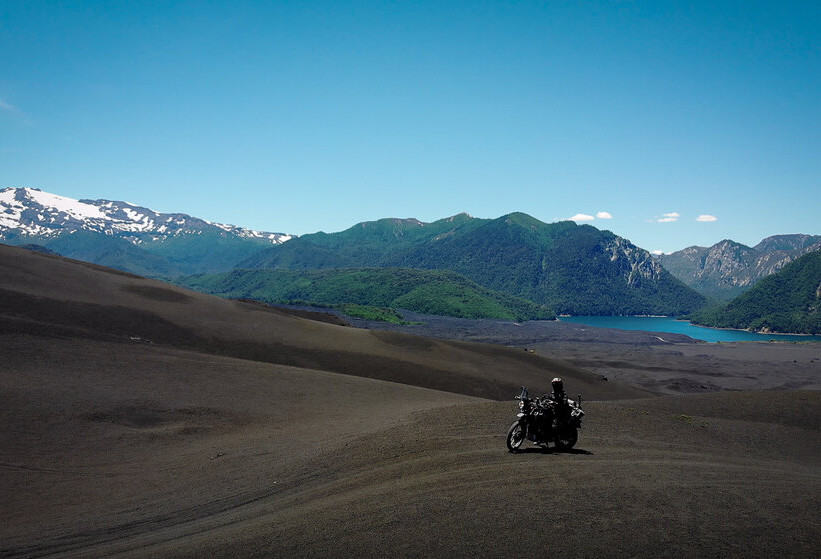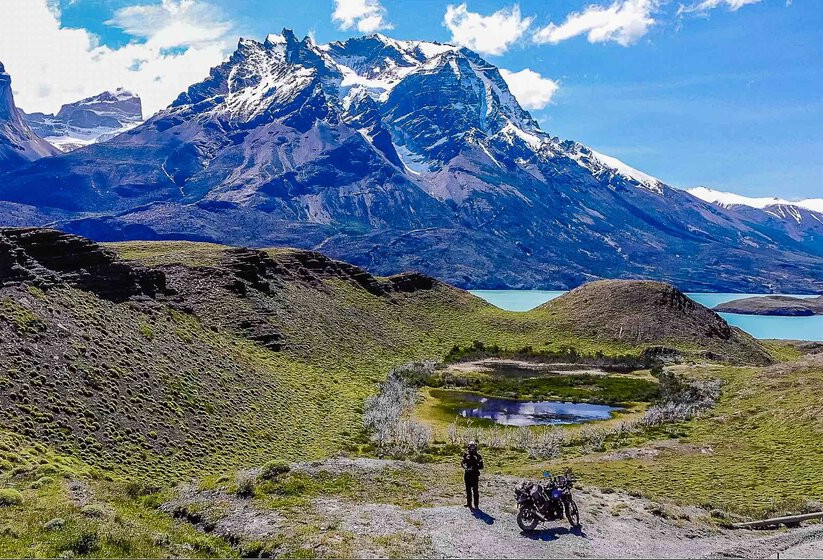
On the ODO: 20.000 km - When the world stopped spinning
15 April 2020With my Royal Enfield Himalayan Dhanno, I almost reached the milestone of 20.000 kilometers before I had to leave her behind in Lima. We traveled until then over barren mountains at 5,000 meters altitude and through the lush green jungle of Bolivia. When we arrived in Peru, the country went into a lockdown due to the COVID-19 pandemic. In the end, I had to return to the Netherlands. I had never thought that my motorcycle adventure could come to such an abrupt halt.
The Ruta de las Lagunas challenge
First, let's go back to the beginning. After I clocked 15.000 kilometers, I took a well needed 3-week break from riding and social media in Salta, Argentina. I wrote articles for my blog, arranged new parts for Dhanno, drank lots of coffee, and watched Netflix. When I felt physically and mentally refreshed again, I continued my adventure and left for Bolivia.
I had set my mind on riding the (in)famous Ruta de las Lagunas: the Lagoon route. I wanted to ride through the wildest part of the Bolivian altiplano by myself. So I quickly crossed the border into Chile, from where I began the Ruta de las Lagunas.
I had already acclimatized to the altitude thanks to my stay in Salta and the rides I made before my arrival in Bolivia. So I didn't have to worry about headaches or altitude sickness, but I was not indifferent to the high altitude of the altiplano either. I was still out of breath after even the slightest physical effort. Scientists found out that at these altitudes, you only have half of the oxygen at your disposal compared to when you are at sea level. That meant that not only I was affected by the altitude but that also Dhanno who lost half of her power.
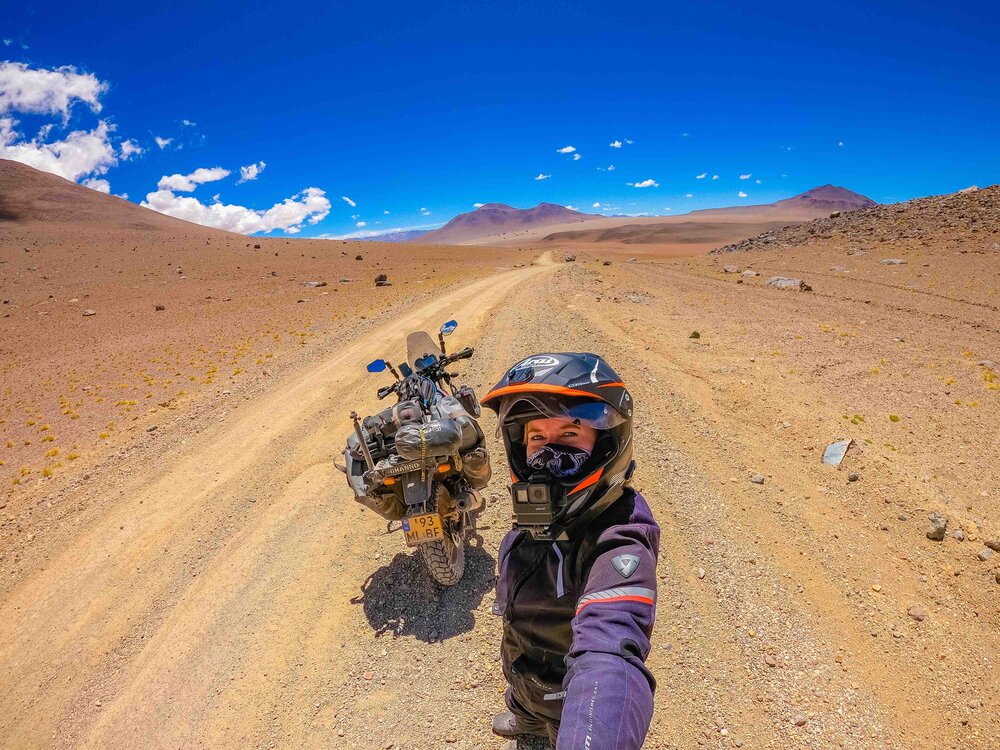
Luckily Dhanno has fuel injection and not a carbureted engine, which makes riding easier when you ride at high altitudes. Nevertheless, the loss of power was clearly noticeable. She stalled more easily when the engine was cold and gaining the right momentum on steep hills was difficult. But besides these little inconveniences, Dhanno pulled me through like the champ she is!
She plowed through deep sand, sticky mud, and puddles of water as if she was at sea level. I contributed by riding extremely careful. I was riding alone and if I would let her fall to the ground, I would have to pick her up by myself, a 200-kilogram motorbike. It would take all my strength and energy to lift her back-up at this high altitude. I was convinced that I would be able to pull it off, but the question was if I would then have enough energy left for the rough roads ahead. You can imagine my relief when I finished the 4-day journey across the altiplano without falling one single time!
Interested to see my challenging and beautiful ride of the Ruta de las Lagunas? In episode 56 I enter Bolivia to begin my ride of the Ruta de las Lagunas.
Riding on the salt flat: yes or no?
My next stop was Uyuni, the gateway to the world's largest salt flat ‘Salar de Uyuni'. Visiting this impressive natural phenomenon was another milestone for me. Unfortunately, the heavy rainfall in the previous days left one meter of water on the salt flat, which made it impossible to ride on. I was disappointed, but at the same time relieved. I knew I would have been tempted to ride the salt flat it there would have only been 10 centimeters of water on it. Many, many motorcyclists have destroyed their bikes by riding through these salty waters. If there was one thing I wanted to avoid, then it would be getting Dhanno into all sorts of electrical problems just because I thought it was cool to ride on a salt flat. Fortunately, I didn't have to make a decision. It was made for me, thanks to the rain.
Impressive visit to the silver mine of Potosi
From Uyuni where I ended my Ruta de las Lagunas, I rode to Potosi. In the past, I have worked in the mining industry of Australia, and I know that working conditions can be terrible in Bolivian mines. Silvermine “Caracoles” in Potosi is situated at 4,400 meters altitude and the conditions inside the mine are atrocious. The air is so toxic that the life expectancy of the workers is only 40 years. On top of that, the danger of a collapsing tunnel is very real.
What was a scary experience for me, is a ‘normal' work environment for thousands of Bolivian people that work in these mines every single day. One of the workers, Pancho, has been working in this mine for 14 years. He showed me around for about 2 hours, and the visit made a deep impression on me. Together we crawled through near vertical narrow shafts, where I could barely breathe. My heart goes out to these workers who have no other choice than to work here in order to feed their family.
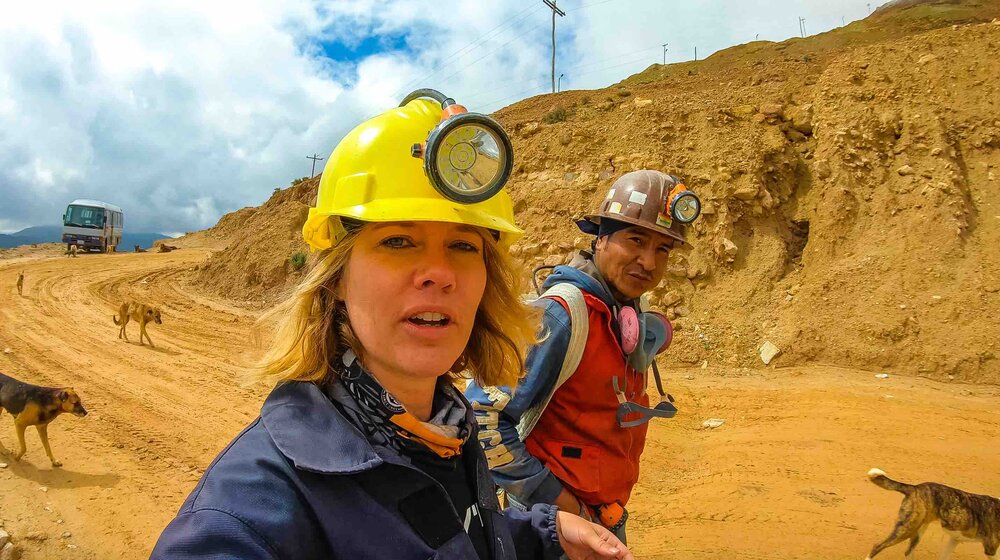
Get down with me into the silvermine in episode 61 of my Patagonia to Alaska adventure.
Riding into the jungle
After two days, I left Potosi and started to descend down from the altiplano. Coming from the high, barren mountains into the jungle over a stretch of only a few hundred kilometers was a huge change. The temperature rose, the air became more humid, and the landscape became lush and green.
Bolivia has an infinite number of narrow dirt roads snaking through the mountains with steep drops on the road's edges. Just the way I like it! In episode 63, I am riding from Maragua in Bolivia to Tomina. One of the most beautiful rides so far.
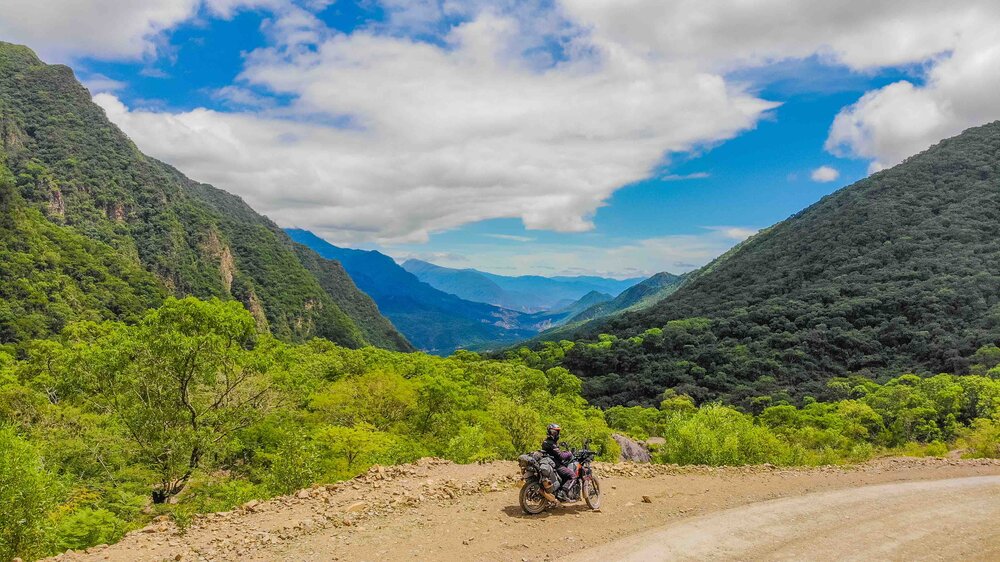
Dangers of the Bolivian jungle
When riding these cool dirt tracks in the mountains, there is only one big enemy: rain. The rainy season was officially coming to an end, but those angry-looking rain clouds above my head did not care! They sent down a few hours of a torrential downpour and turned these great dirt tracks into sucky and sticky mud roads. What was even more challenging, were the natural streams I had to cross. These streams quickly changed from shallow and clear water streams into violent brown mudflows.
On my ride to the isolated town Independencia, I had to deal with one of them. It was the first time during my entire adventure ride, that I decided to get off Dhanno and walk through the mud stream first. The water was fast flowing and parts of trees and rocks were taken by it. I could feel the rocks hitting my boots underwater while I walked through it. I crossed the stream 6 times, and every time it felt different. The strong current changed the course and depth within seconds. I waited for some time, hoping that somebody would show up to help, but in the end, I had to cross it by myself. It was still raining and the situation would only get worse if I waited any longer.
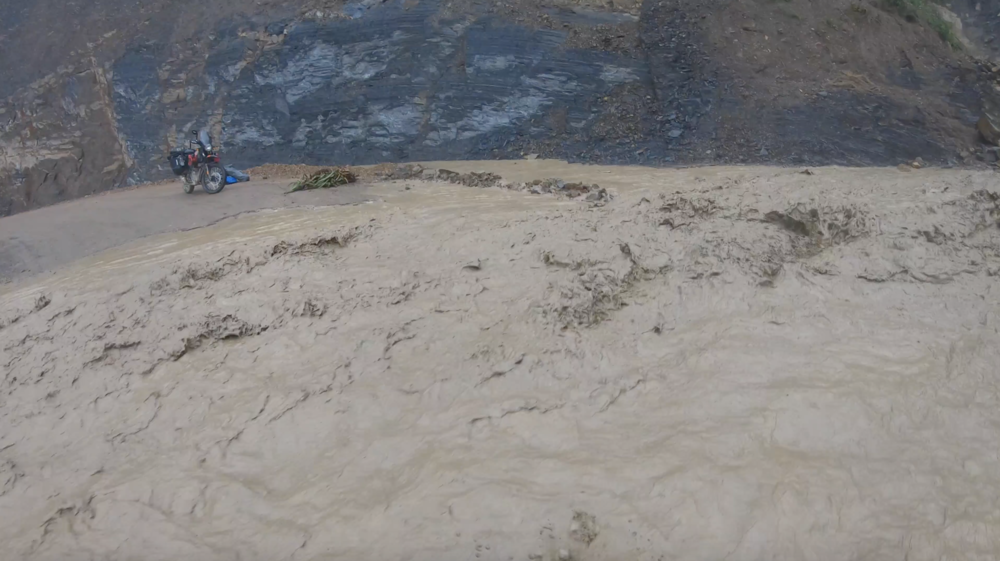
I made it across, but don't ask me how! At this point, I realized two things. How much my skills as an off-road rider had improved and how careful you have to be with rain in these parts of the world. One year ago, I would never have managed to cross such a wild and dangerous stream.
During this ride, Dhanno's speedometer stopped working. The cable got damaged (probably by a rock) and she was not indicating my speed anymore. More importantly, she wasn't adding kilometers to my ODO! I had the cable fixed when I reached La Paz, but by that time I had ridden another 500 kilometers that was not clocked.
You can watch me cross this heavy flowing mud stream in episode 67.
COVID-19 outbreak
Soon my struggle with this water crossing and the broken speedometer seemed insignificant to the worldwide problems with the outbreak of COVID-19. I had just settled into La Paz in Bolivia and was enjoying a ‘normal' life of going to the gym, meeting locals, and acting as if I lived there already for many years when things took a turn for the worse. Within a time span of several days, half the world had gone in lockdown and closed their borders.
As soon as I heard that Bolivia was going to close the border with Peru, I grabbed all my stuff, jumped on Dhanno and we made a run for Peru. At that time, the outbreak in South America was still very small compared to the crisis in Europe and it looked like they were just closing the borders for foreigners so they could not enter the country anymore. My reasoning was that if I made it to Peru, I would have two months to make it to the border with Ecuador, which would hopefully be open again by that time.
So I continued my journey in Peru with a visit to the island Taquile situated on Lake Titicaca. On the way there, the boat also made a stop at one of the floating islands, which was fascinating. You can see my first and last activity in Peru in episode 70.
The next morning, I heard that the Peruvian government announced a complete lockdown for the country, starting that evening. Everybody had to stay at home for 15 days. I considered my options: staying on Taquile or going back to the mainland. I didn't have an internet connection on the island, Dhanno was by herself in some community building on the mainland, there were no shops of any kind on the island and the last boat was leaving that morning.
I decided to go back to the mainland, to Puno, and find a safe haven to sit out the lockdown.
In lockdown and evacuation from Peru
Staying in the big city of Puno for the lockdown didn't appeal to me at all, so I decided to ride to a small, high altitude town called Lampa. The first 5 days in Lampa were all fine. I stayed inside my small room most of the time, but I also could go outside by myself for a walk in nature.
But things changed quickly when the police spotted me. Because of my European appearance and because I happened to be the only foreigner in town, everybody quickly assumed I was infected with COVID-19. It set off a chain of events in which I got visited by hospital employees, the Ministry of Public Health, the chief of police, the tourism police, the mayor of Lampa, and the governor of the province. On local social media, my stay in Lampa was shared and discussed. I felt increasingly unsafe as the only foreigner in a small town.
If there would be a corona outbreak in this town, I was certain that I was going to be blamed for that. In times of extreme fear, people can react unpredictably and I was worried an angry mob would come after me. So I decided to ask my embassy for options to get out of Peru. It took another 10 days before everything was arranged. Together with the Peruvian authorities, they organized a permit so I could travel the 1200 kilometers to Lima. Unfortunately, I was not allowed to travel on my motorbike, and as I didn't want to leave Dhanno behind in Lampa, I had to find a driver with a pick-up truck. With the help of the hostel owner, we found someone trustworthy.
Together we traveled to Lima, with Dhanno on the back of the pick-up truck. There I waited another 7 days for my flight back to the Netherlands. These three weeks of my lockdown in Peru and trying to get out of Peru definitely rank as one of my most stressful and bizarre travel moments so far.
What's next?
Good question. I had to leave Dhanno behind in Lima. She is parked there safely. Hopefully, the world will get back on its feet and I will be able to finish my journey to Alaska. But it all depends on how things will develop around the world in the next few months.
There are so many uncertainties. When will there be a vaccine? When will the international borders open again? And how long are there going to be travel restrictions? Will it still be safe to travel if economies have completely collapsed? Will locals in South America still look at foreigners with hostility and suspicion when tourists start traveling again?
In these times, when people are losing their relatives and so many people have lost their jobs, I don't want to think about going out and travel. Even though traveling is my life and job, without it I am a little lost to be honest.
All I can do now is to take good care of myself and others. And I am sure I will find other ways to walk my Itchy Boots in the upcoming months!
You mentioned your motorcycle, Dahno, is damaged and can't be repaired. How did this happen?
Would also like to know
Hi Tom and Jessh, you can find the answer on my FAQ-page :-) When she returned from Peru, she was in a terrible shape.

How did I miss this! Great summary, very well written, as you a good "word smith" too Noraly.


